
A SURVEY ON NOMA WITH THE AID OF INTELLIGENT REFLECTING SURFACE IN WIRELESS COMMUNICATION
1 Faculty
of Electronics Technology, Industrial University of Ho Chi Minh City, Ho Chi Minh
City, 700000, Viet Nam
|
|
ABSTRACT |
||
|
Non-orthogonal
multiple-access (NOMA) and its enhanced versions are potentially emerging
technologies which contribute to boost the blossoming of the wireless signal
propagation in the mobile and IoT era. In this paper, an overview of the NOMA
communication mechanism with the aid of intelligent reflecting surface (IRS)
is presented. The survey shows that the IRS-based NOMA allows communicating
even in the areas with the weakest signals so that the NOMA-aided wireless
designers can have an insight into improving the performance of wireless
communication networks. In particular, a comparison of key characteristics of
NOMA with IRSs and relays is also presented. In addition, the challenges and
applications of this type of NOMA are also discussed. Besides, the formulas
of the signals at the sources and destinations of background NOMA
communication systems are also analyzed. This survey thus provides a
background of IRS-employed NOMA for deeper studies of this technology. |
|||
|
Received 02 June
2024 Accepted 05 July 2024 Published 01 August 2024 Corresponding Author Thi Dep Ha, hathidep@yahoo.com DOI 10.29121/granthaalayah.v12.i7.2024.5718 Funding: This research
received no specific grant from any funding agency in the public, commercial,
or not-for-profit sectors. Copyright: © 2024 The
Author(s). This work is licensed under a Creative Commons
Attribution 4.0 International License. With the
license CC-BY, authors retain the copyright, allowing anyone to download,
reuse, re-print, modify, distribute, and/or copy their contribution. The work
must be properly attributed to its author.
|
|||
|
Keywords: NOMA, C-NOMA, IRS, IRS-aided-NOMA, UAV,
IoT, V2X |
|||
1. INTRODUCTION
With rapidly explosive growth of the demand of wireless communications, almost devices and systems are designed to trend to connect together via electromagnetic wave environment, e.g., smart home, UAV, healthcare Li et al. (2022), Jiao et al. (2020), Chen et al. (2022), Cai et al. (2022), Budhiraja et al. (2021). The traditional orthogonal multiple-access (OMA) technologies, such as time division multiple access (TDMA) and frequency division multiple access (FDMA), have exhibited their limitations in improving the performance of the wireless communication systems. These include the coverage, spectral efficiency, data rate, latency, and energy solutions Li et al. (2022), Wang et al. (2021), Wang et al. (2022). Therefore, non-orthogonal multiple access (NOMA) Islam et al. (2016), Liu et al. (2017), Saito et al. (2013) technology solution has contributed to open the new era of wireless communication, expanding from smart agriculture, healthcare, industry, transportation, rescue to mobile and satellite communications. NOMA exploits two key techniques, including successive interference cancellation (SIC) Wang et al. (2021), Islam et al. (2016), Liu et al. (2017), Ding et al. (2022), Cai et al. (2017) and superimposed coding (SC) Wang et al. (2021), Islam et al. (2016), Liu et al. (2017), Kara & Kaya (2018), Wei et al. (2022), to combine and decode the signals of users when transmitted and received, respectively. The SC technique is to perform the summation of the signals of users sent to the base station (BS). The SIC is utilized to decode the superimposed signal received from the BS. In NOMA, many users are allocated the same resource, e.g. frequency, time, and code, at the same time Li et al. (2022), Aldababsa et al. (2018). There are various NOMA techniques have been introduced in the last decades such as power-domain NOMA (PD-NOMA) Budhiraja et al. (2021), Aldababsa et al. (2018), Yang et al. (2017), code-domain NOMA (CD-NOMA) Budhiraja et al. (2021), Aldababsa et al. (2018), and hybrid NOMA (H-NOMA) Al-Obiedollah et al. (2023), Deka & Sharma (2022). The PD-NOMA is the most commonly deployed-NOMA version. The CD-NOMA ranges from LDS-CDMA, LDS-OFDM, to SCMA. The H-NOMA combines the advantages of two above mentioned-NOMA mechanisms.
Although owning several benefits to OMA, the NOMA also shows its drawbacks in communication. These are the coverage area, the propagation with the obstacles. Therefore, the cooperative NOMA (C-NOMA) Liu et al. (2019), Beddiaf et al. (2022) has been introduced as a potential candidate to improve the existing limitations of the NOMA. By aiding the users with weak channel conditions via establishing indirect links between transmitting sources to the desired destinations, C-NOMA contributes to extending the coverage of the source and enhancing the communication effectiveness. To forward the information from the sources to the destination users, a C-NOMA networks need to be equipped single- or multiple-relays Gao et al. (2023), Awsathi & Babu (2021). The relays can rely on user groups or separated designed relays. The information is forwarded by the relays using the decode-and-forward (DF) or amplify-and-forward (AF) protocols Aldababsa et al. (2018), Lima et al. (2022).
Compared to relay-aided C-NOMA, NOMA based on intelligent reflecting surface (IRS) Li et al. (2022), Al-Obiedollah et al. (2023), Zhu et al. (2022), Ihsan et al. (2022) provides outperformed features such as controllable signal propagation, smart radio environment. IRS is introduced tend to sixth generation (6G) communication networks, where the frequency band is expected to expand to terahertz (THz) and boost a much higher throughput, in terms of the peak data rate about more than 1 terabit per second (Tbps) and thus 100-1000 times increasing, over 5G Zhu et al. (2022), Naeem et al. (2022). The reasons to push this frequency into sub-THz-band are because it offers a higher data rate, resulting in a faster transmission, and more accessible users. However, the higher the wave propagation frequency, the higher the attenuation, and the narrower the coverage is. These cause the increase of energy consumption and more required-BS number. In addition, with the properties of the short wavelength, the propagation links can be broken when reaching the physical obstacles. The IRS thus becomes a promising candidate to solve this propagation problem. Besides, the IRSs may solve the energy problem more efficiently due to their lower power consumption property over the relay-based NOMA communication Naeem et al. (2022). Thus, this technology permits reach the standards of the green communication network Naeem et al. (2022). Generally, IRSs are known as meta-surfaces which can programmable change the phase of electromagnetic waves and redesign the channels based on reflection phenomenon.
In this paper, we discuss an overview of IRS-assisted NOMA for uplink and downlink communications, a comparison of main features between IRS- and relay-based NOMA. Furthermore, we also analyse the benefits and drawbacks of IRS-aided NOMA over C-NOMA and OMA technologies. In addition, the expressions of the received and transmitted signals at users and BSs, respectively, for numerous communication models of NOMA, IRS-aided NOMA are also provided. Finally, the applications along with the challenges of this NOMA technique are also summarized as an offer for deeply finding IRS-NOMA research directions.
Table 1
|
Table 1 List
of Main Acronyms |
|
|
Acronyms |
Definition |
|
AF |
Amplify-And-Forward |
|
AWGN |
Additional White Gaussian Noise |
|
B5G |
Beyond 5G |
|
BS |
Base Station |
|
C-NOMA |
Cooperative NOMA |
|
CR |
Cognitive Radio |
|
CSI |
Channel State Information |
|
CD-NOMA |
Code Domain-NOMA |
|
DF |
Decode-And-Forward |
|
EH |
Energy Harvesting |
|
FD |
Full Duplex |
|
FDMA |
Frequency Division Multiple Access |
|
HD |
Half Duplex |
|
H-NOMA |
Hybrid-NOMA |
|
IoE |
Internet-of-Everything |
|
IoT |
Internet of Things |
|
IRS |
Intelligent Reflecting
Surface |
|
LDS-CDMA |
Low Density Spreading Code Division Multiple
Access |
|
LDS-OFDM |
Low Density Spreading Orthogonal
Frequency-Division Multiplexing |
|
LoS |
Light-of-Sight |
|
MIMO |
Multiple Input Multiple Output |
|
MUSA |
Multi-User Shared Access |
|
NOMA |
Non-Orthogonal Multiple-Access |
|
OMA |
Orthogonal
Multiple-Access |
|
PDMA |
Pattern Division Multiple Access |
|
PD-NOMA |
Power Domain-NOMA |
|
RF |
Radio Frequency |
|
SC |
Superimposed Coding |
|
SCMA |
Sparse Code Multiple Access |
|
SIC |
Successive Interference Cancellation |
|
SISO |
Single Input Single Output |
|
SWIPT |
Simultaneous Wireless Information and Power
Transfer |
|
TDMA |
Time Division Multiple Access |
|
UAV |
Unmanned Aerial Vehicle |
|
V2X |
Vehicle-to-Everything |
|
WPT |
Wireless Power Transfer |
|
WPCN |
Wireless Powered Communication network |
|
5G |
Fifth Generation |
|
6G |
Sixth Generation |
2. BACKGROUND OF NOMA TECHNIQUE
2.1. NOMA operating principles
The NOMA technology has been expecting as the heart of communication systems in 5G and B5G. It is a non-orthogonal multiple access where multiple users are allowed to share communication resources. These resources can be frequency, time, space, or code. The main motivation of NOMA-based communication networks is to deeply improve the data rate, latency, user capacity, energy harvesting, and spectral efficiency, particularly. Besides, a highlight feature of the NOMA offers the solutions for limited battery capacity of the wireless communication devices via energy harvesting (EH) protocols.
Two dominant mechanisms exploited in NOMA technique include SC and SIC. SC is known as a signal combining technique. It is employed at transmitting side, i.e. BSs. To perform the SC, all users are multiplexed on the same subcarrier with different received power levels and the received signal at the BS is the superimposed one of these users Islam et al. (2016), Wei et al. (2017). In contrast, SIC is a successive interference cancellation technique. It is utilized at receiving side, i.e. users Wang et al. (2022), Islam et al. (2016). The mechanism of SIC is based on the strength of the received signals and sequential decoding process. Specifically, the signal of the weakest user which has the highest power allocation coefficient first decoded, the signal of the next user is decoded by subtracting the superimposed signal and this decoded signal. This implies that the signal of each user is decoded following the decreasing amplitude of the signals. To perform SIC, the signal of other users is treated as interference sources of the decoding user. Both techniques have been proposed in Ni et al. (2021)
Figure 1

|
Figure 1 Illustration
of a Simple NOMA System with Two Users and One BS |
To demonstrate the properties of SC and SIC, let consider a basic NOMA communication system with one BS and two users as shown in Figure 1 In this system, the location of user 1 is assumed nearer than that of user 2 from the BS. The channel condition of user 1 is thus stronger than that of user 2. As a result, user 1 is allocated less power than user 2 to ensure the fairness of NOMA mechanism. In this model, the superimposed signals x1 and x2 of two users, respectively, is transmitted by the BS to two users.
The NOMA-combined signal of two users at the BS is expressed by Islam et al. (2016), Wei et al. (2016)
![]() (1)
(1)
where Pi (i = {1,2}) indicates the BS’s power allocation to two users, respectively.
The Pi depends on the transmission power Ps at the BS and its power allocation coefficient ai. The principle of the power allocation mechanism in NOMA is to satisfy fairness among users. This means that the weakest user is allocated the highest power, and the strongest user is given the lowest power. The Pi is thus given by
![]() (1)
(1)
The received signal for each user is calculated by [8,38]
![]() (2)
(2)
Where hi indicates the channel coefficients of the two users, respectively, and n denotes for the additional white Gaussian noise (AWGN).
At the receiver, i.e. two users, the SIC technique is employed to decode the signal of each user. Specifically, user 2 detects its own signal without SIC process. This is because it is given a highest power level and thus treats the signal of user 1 to be interference. In contrast, user 1 first employs the SIC process to cancel the information of user 2 and then decodes its own signal.
Generally, the summation and decoding mechanisms of the signals for the case of multiple users are also processed following the same way of the case of two users. Herein, let consider a NOMA system with N-users as illustrated in Figure 2
Figure 2
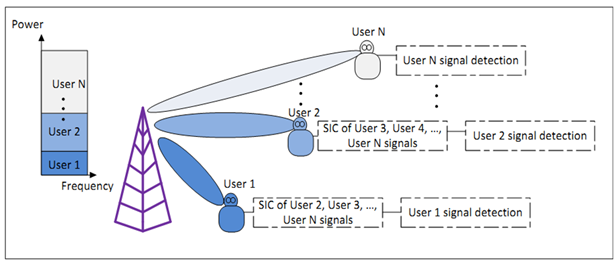
|
Figure 2 Illustration
of SIC Process in a NOMA System with Multiple Users |
Similarly, the superimposed signal for multiple users, i.e. N users, at the BS can be expressed by
![]() (1)
(1)
where Pj (j = {1, 2, N}) is the BS’s power allocation to multiple users, respectively.
The received signal expression for jth user is calculated by
![]() (2)
(2)
Figure 3
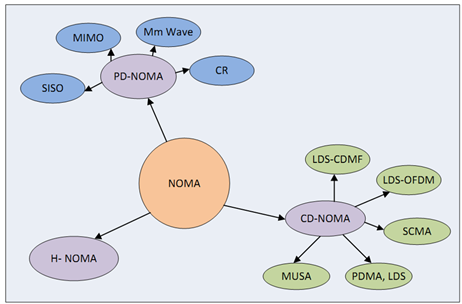
|
Figure 3 A Basic
Classification of NOMA |
Figure 3 shows the categorization of the NOMA technology. Basically, NOMA is divided into three types, including PD-NOMA, CD-NOMA, and H-NOMA.
2.2. Cooperative NOMA
Due to the barriers of physical objects, e.g. high trees, buildings, and hills, the propagation links of wireless signal can be blocked. The signals cannot reach the users behind these obstacles. This seems to exhibit the weakness of the NOMA technology. Therefore, C-NOMA Liu et al. (2019), Beddiaf et al. (2022) has been introduced to solve the coverage of NOMA. In C-NOMA mechanism, it selects single user or a group of multiple users to relay the information to desired users Gao et al. (2023), Awsathi & Babu (2021). The elected users are known as relays. In C-NOMA systems, there always exist indirect links to the destination nodes while the direct links sometimes do not occur. The relay users have a good channel condition.
Figure 4(a) illustrates a basic C-NOMA network model with one BS one two users. As shown in the figure, user 2 is assumed to have a weak channel condition and blocked by a building, while user 1 directly receives the signal from the BS. This means that the propagation link of the signal from the BS cannot reach to user 2. Thus, this user needs an assistance of user 1 to get the information from the BS. Therefore, user 1 is known as the role of a relay user. The link from the BS to user 2 is an indirect link.
Besides, in C-NOMA systems, relays can be single relays, as aforementioned, or a group of relays. These relay groups forward the superimposed signal from the BS or decoded signal to destination one or more users. Normally, among users of the group, one user with the best channel condition is selected to relay the information. There are numerous strategies of relay selection. The relays can operate in half duplex (HD) or full duplex (HD) mode depending on their number of equipped antennas. Specifically, a relay may be integrated with single or multiple antennas. The coming information either is decoded or amplified at the relays prior to forwarding the destination nodes. These two employed protocols at the relays are decode-and-forward (DF), and amplify-and-forward (AF), respectively.
Figure 4 shows a simple C-NOMA model with one BS and two users, where the user 1 acts as a relay to forward the information from the BS to the user 2 in both cases of with and without obstacles.
Figure 4
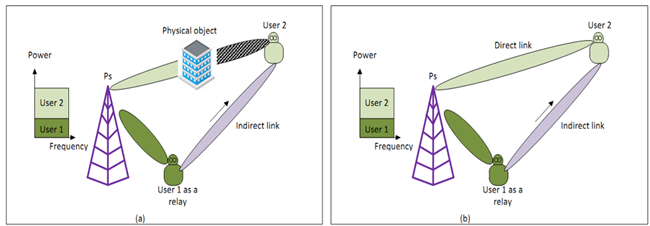
|
Figure 4 Illustration of a Two User C-NOMA System with (A) Only Indirect Link, and (B) Both Direct and Indirect Links |
Figure 5 illustrates an extended C-NOMA version. In this version, multiple relays are deployed to enhance the performance of the systems in terms of the best selecting solutions.
Figure 5
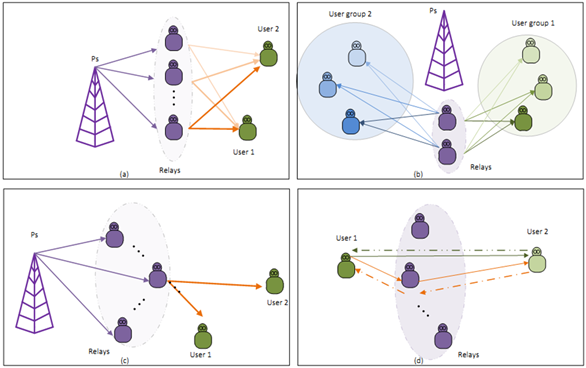
|
Figure 5 An Enhanced Version of a Relay Group-Aided C-NOMA System with (A) Multiple Relays, (B) Multiple Relays and User Groups, (C) the Best Relay, and (D) Multiple Two Way-Relays |
Figure 6 illustrates the classification tree of the C-NOMA. With the number of relays utilized in the NOMA communication systems, this tree consists of single relay and multiple relays, where the multiple relay group is classified into the single-stage relay and multipoint relay.
Figure 6
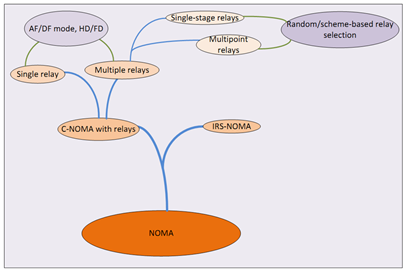
|
Figure 6 Classification of Relay-Assisted C-NOMA |
2.3. Intelligent reflecting surface in NOMA
Intelligent reflecting surfaces (IRSs) Wang et al. (2022), Yang et al. (2017), Al-Obiedollah et al. (2023), Gong et al. (2020) have been expecting as an emerging and revolutionary solution to overcome the drawbacks of NOMA in improving the signal strength for 6G networks as well as the propagation environment Wang et al. (2022), Yang et al. (2017), Awsathi & Babu (2021), Zhu et al. (2022). An IRS is a meta-surface integrated a large number of controlled-reflecting elements. These elements can reconfigure the signals with the distinct phase and amplitude changes via integrated programmable circuits. As a result, the IRSs are able to reflecting and steering impinging waves toward any desired direction. This is passive beam-forming mechanism. The key benefit of IRS is an enhanced effective channel gain and more reliable receiving signal. Nature of the IRSs is not able to generate any information to transmit. Meanwhile, they are not the original sources of the information, just act like relays Ding et al. (2020). In addition, compared to the relay technology, the energy consumption in IRSs is reduced since they are equipped by almost passive elements.
Basically, the structure of an IRS contains three layers, as illustrated in Figure 7 The top layer, namely meta-atoms, is made of dielectric and metallic materials. The middle layer is copper panel which avoids the leakage of signal’s energy. Finally, the bottom layer consists of integrated IRS intelligent controllers, as known a control circuit board, which is to adjust reflecting elements Wang et al. (2022)
Figure 7
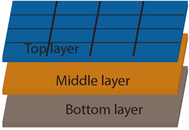
|
Figure 7 A Structure of an IRS |
The IRSs are deployed in both uplink and downlink of NOMA-based wireless communication systems. The IRSs are categorized into passive IRS and active IRS Fu et al. (2023), Di Renzo et al. (2020), as shown in Figure 8 While the active IRSs are designed to amplify the power gain via negative resistance components Fu et al. (2023), the passive IRSs are to shift phase/amplitude of the signal from the source.
Figure 8
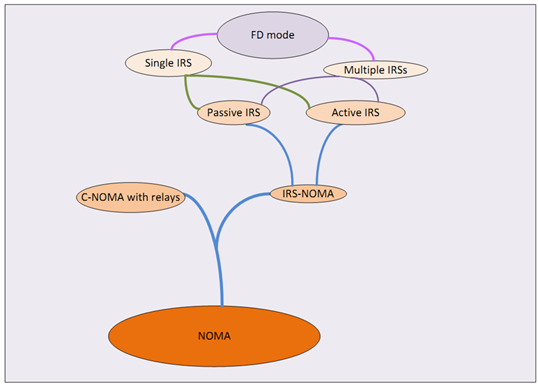
|
Figure 8 Classification of IRS-Assisted C-NOMA |
Similar to the relays in C-NOMA, the IRSs are normally located between a transmitting-source, e.g. BS, and users which no direct links occur [16,43]. In particular, a hybrid cascade of passive IRSs and active IRSs also introduced to boost the coverage of a wireless system Fu et al. (2023).
Let consider an IRS-enabled NOMA system with one BS and two users. Between the BS and users does not exist light-of-sight (LoS) links due to a physical object, as illustrated in Figure 9 Meanwhile, the system needs to equip assistant objects to communicate each other. Herein, an IRS is placed between the BS and user group to avoid the obstacle.
The received signal for jth user is expressed by Fang et al. (2020)
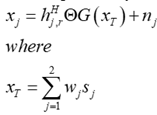 (2)
(2)
Where ![]()
![]() denotes the channel gain from the IRS to jth
user, G denotes the channel gain from the BS to the IRS
denotes the channel gain from the IRS to jth
user, G denotes the channel gain from the BS to the IRS ![]() , is the additive white Gaussian noise at user j,
, is the additive white Gaussian noise at user j, ![]() is the broadcasting
signal from the BS,
is the broadcasting
signal from the BS, ![]() is the beam-forming vector for user j,
is the beam-forming vector for user j, ![]() is the
information-bearing signal for user j,
is the
information-bearing signal for user j, ![]() is the reflection matrix of the IRS,
is the reflection matrix of the IRS, ![]() is the amplitude
reflection coefficient,
is the amplitude
reflection coefficient, ![]() is the reflection phase shift.
is the reflection phase shift.
Figure 9
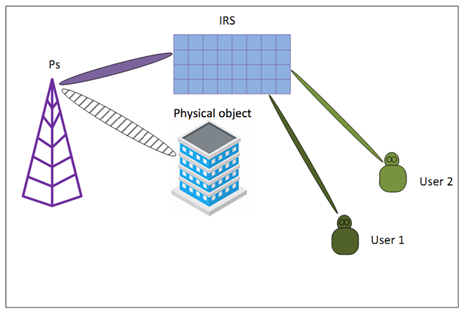
|
Figure 9 Illustration
of IRS-Aided NOMA Model without Direct Link. [3n] |
Similar to Figure 9, Figure 10 illustrates an IRS-assisted NOMA with the presence of the direct link from the BS to two users Yang et al. (2017).
Figure 10
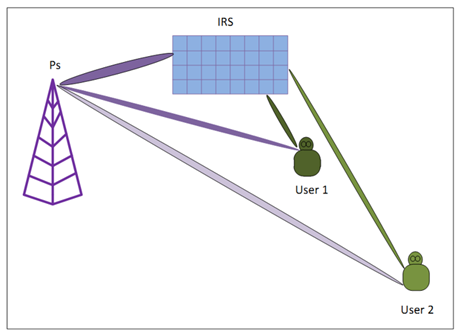
|
Figure 10 Illustration of IRS-Aided NOMA Model with both Direct and Indirect Links |
Besides using single IRS to serve multiple users in a cell, it is also deployed for multiple users at several different cells in the wireless communication systems, as illustrated in Figure 11(a) Ni et al. (2021). Moreover, the IRSs are also cascaded to expand the coverage due to numerous obstacles in the wave propagation, as shown in Figure 11(b) Fu et al. (2023).
Figure 11

|
Figure 11 Illustration of IRS-Aided NOMA Model With (A) Multiple Cells, and (B) Multiple Irss |
3. MAIN FEATURE COMPARISON OF IRS- AND RELAY-ASSISTED NOMA COMMUNICATION NETWORKS
As aforementioned, both C-NOMA and IRS assisted-NOMA are enhanced versions of the NOMA technology. The most importance motivation of these techniques is to improve the performance as well as reduced the cost of the system. Table 2 lists a detailed comparison of the key features between two these expanded-NOMA techniques.
Table 2
|
Table 2 A Comparison of the Key Features between IRS-Aided NOMA and Relay-Assisted NOMA |
||
|
Features |
IRS-aided NOMA |
Relay-assisted C-NOMA |
|
Hardware cost Ni et al. (2021) |
Lower |
Higher |
|
Circuits/Hardware Di Renzo et al. (2020) |
Simple |
Complex |
|
Materials Di Renzo et al. (2020) |
Cheap |
Expensive |
|
Energy consumptions Ni et al. (2021), Di Renzo et al. (2020) |
Low |
High |
|
Encoding and decoding information Di Renzo et al. (2020) |
No |
Yes |
|
Channel gain Yu et al. (2022) |
Tunable |
No |
|
Enhancing coverage range Yu et al. (2022) |
Higher |
Lower |
|
Data rate, throughput |
Higher |
Lower |
|
Multi-cell communications Ni et al. (2021) |
Easy |
No |
|
Full-duplex mode without involving interference Wang et al. (2021) |
Yes |
No |
|
Performance Ihsan et al. (2022), Yu et al. (2022) |
Minimized energy consumption, low time latency,
reduced interference, enhanced security |
High energy consumption, high time latency |
|
Eavesdrop Attacks Wang et al. (2021), Wang et al. (2022), Liu et al. (2022), Mu et al. (2020) |
Not easy |
Easy |
|
Security Wang et al. (2021), Ihsan et al. (2022), Wang et al. (2021) |
High physical layer security, reflected signals
at eavesdroppers are suppressed |
eavesdroppers easily capture the relaying signals |
4. CHALLENGES OF IRS-AIDED NOMA
4.1. Eavesdropping
Eavesdropping attacks Wang et al. (2021), Wang et al. (2022), Liu et al. (2022), Mu et al. (2020) commonly happen in wireless communication network systems using electromagnetic waves and are also one of bottlenecks in NOMA-based communication applications. Unlike the traditional wired links, the wireless RF signals propagate in any direction with omnidirectional antennas or in desired one with directional antennas in the air/space environments. This may be the object of signal detected-attacks, e.g. eavesdropper. Therefore, this type of communication is easily compromised by eavesdropper. For IRS-assisted NOMA, integrating the IRSs introduces an extra reflection link and also provides a chance to enhance the received signal for the eavesdroppers, in particular for the potential ones with unknown (channel state information) CSI Budhiraja et al. (2021). Numerous studies have proposed schemes to disrupt this eavesdropping. In Budhiraja et al. (2021), an artificial jamming aided- IRS based-NOMA scheme has been proposed. This scheme generates the jamming signal with NOMA information. In Wang et al. (2022), two beam-forming-based security schemes, namely the artificial jamming and joint pre-coding and IRS reflecting beam-forming, have been investigated for blocking both internal and external eaves-droppings.
4.2. Channel Acquisition
Another important challenge in IRS-aided NOMA networks is the ability of accurate channel estimation Wang et al. (2021), Wang et al. (2022), Zhu et al. (2022), Naeem et al. (2022). The more accurate the estimation is, the higher the system performance. The embedding of more IRSs into the system generates additional links and more channels between IRSs-users and source-ISRs. Thereby, more phase shifts and channel coefficients need to be estimated. In particular, this issue becomes more complex in UAV-NOMA systems where their mobility and channel random are extremely high.
5. APPLICATIONS OF IRS-ASSISTED NOMA
5.1. IRS for UAV-enabled communication
The IRSs have been deployed in UAV-ground communication network systems Jiao et al. (2020), Cai et al. (2022), Liu et al. (2022), Naeem et al. (2022). The UAVs are exploited at zones where the transmitting signals from the BSs cannot propagate to desired destination nodes due to a lack/destroy of infrastructures, earthquake, and rescue. These UAVs operate as a flying BSs to serve multiple ground users. The integration of IRSs into UAV-NOMA systems enables the flexibility of 3D trajectory design of UAVs and enhances thus the data rate of the system as well as reducing their flying power consumption Cai et al. (2022). By applying passive beam-forming mechanism, an array gain in reflection links of IRSs is highly rich. In summary, the deployment of IRS along with UAV communication in NOMA-based network systems allows improving the data rate and minimizing the average power consumption.
5.2. IRS for IRS-assisted BSs in mobile communication network
In mobile communication networks, IRS can be mounted on the buildings, windows, and indoor walls Liu et al. (2022), Ihsan et al. (2022). The IRSs have been developed for 6G communication networks to serve an extremely huge number of interconnected devices. The purposes of 6G networks are to boost the data rate, about a thousand of times, achieve a very low latency, and reduce the consumption of energy power. Therefore, with the assistance of the IRSs embedded into the systems, the video streaming and real-time data and video transmission can be easily deployed. In addition, using the IRS along with multiple antennas equipment of the BS in mobile communication networks strongly pushes the serving ability of the systems for multiple cells communication.
5.3. IRS for Intelligent Transportation Systems with Vehicle-to-everything (V2X) communication [3n]
Similar to mobile network systems, the application of the IRSs in V2X communication is exploited by attaching on roadside billboards. This V2X communication expands from vehicle-to-vehicle (V2V), vehicle-to-infrastructure (V2I), to vehicle-to-pedestrian (V2P) Zhu et al. (2022), Huang et al. (2023). Since the 6G technology concept aims to increase the data rate, thus the throughput, by 1000 times compared to the one of the 5G, as aforementioned, it offers benefits for deploying in the vehicles networks for smart transportation systems, e.g. driving safety, risk reduction, communication stability, and communication security Zhu et al. (2022).
5.4. IRS for IRS-assisted BSs in IoT/IoE communication network
The IoT/IoE devices are always constrained by their cost and size requirements, e.g. low cost and small size. Meanwhile, their battery capacity and processor performance are limited. An efficient solution is thus necessary to overcome these drawbacks. RF-aided wireless power transmission (WPT) is a promising technology to prolong the lifetime of the battery. This approach has been exploited in C-NOMA with relays and shown their effectiveness. With inheriting this WPT mechanism, the IRS technology also exploits its benefits of high reflecting passive beam-forming gain to appeal for WPT to recharge the battery of IoT/IoE devices Li et al. (2022), Chen et al. (2022), Zhang et al. (2021). As a result, the efficiency of the wireless power transfer and information transmission obtains highly. This WPT technique can be deployed for both simultaneous wireless information and power transfer (SWIPT) and wireless powered communication network (WCPN) systems.
Figure 12 illustrates the applications of IRSs in UAV, mobile, smart transportation, and IoT/IoE communication network systems in environments with different conditions.
Figure 12

|
Figure 12 Applications
of IRS-Assisted NOMA in Several Above-Mentioned Fields |
6. CONCLUSION
This paper has overviewed an insight survey of NOMA, IRS-aided NOMA, a comparison between C-NOMA and IRS-NOMA, the challenges of IRS-NOMA, and the applications of IRS-NOMA in cellular and IRS-assisted UAV-enabled IoT networks and V2X. The discussion of two basic concepts of NOMA and C-NOMA, namely SIC and SC techniques were presented. In particular, a hardware description of a IRS structure were illustrated. In addition, two simple NOMA/IRS-NOMA system models with one BS- two users and one BS-one IRS-two users, respectively, were also analysed as deeply illustrations. The expressions of the received signal with/without IRS of these models were also provided. Furthermore, the integration of IRSs in the applications of cellular, IoT, UAV, V2X communication networks was further discussed. Finally, two of main challenges in terms of eavesdropping and channel acquisition were also addressed.
CONFLICT OF INTERESTS
None.
ACKNOWLEDGMENTS
The authors appreciate the anonymous reviewers for their help in reviewing as well as careful reading our manuscript so that we can get insightful comments and suggestions.
REFERENCES
Al-Obiedollah, H., Salameh, H. A. B., Cumanan, K., Ding, Z., & Dobre, O. A. (2023). Self-Sustainable Multi-IRS-Aided Wireless Powered Hybrid TDMA-NOMA System. IEEE Access, 11, 57428-57436. https://doi.org/10.1109/ACCESS.2023.3284317
Aldababsa, M., Toka, M., Gökçeli, S., Kurt, G. K., & Kucur, O. (2018). A Tutorial on Nonorthogonal Multiple Access for 5G and Beyond. Wireless Communications and Mobile Computing, 1. https://doi.org/10.1155/2018/9713450
Alkhawatrah, M. (2022). The Performance of Supervised Machine Learning Based Relay Selection in Cooperative NOMA. IEEE Access 11, 1570-1577. https://doi.org/10.1109/ACCESS.2022.3233443
Awsathi, V., & Babu, A. V. (2021). Outage and Throughput Analysis of Full-Duplex Cooperative NOMA System with Energy Harvesting. IEEE Transactions on Vehicular Technology, 70(11), 11648-11664. https://doi.org/10.1109/TVT.2021.3112596
Beddiaf, S., Khelil, A., Khennoufa, F., Kara, F., Kaya, H., Li, X., Rabie, K., & Yanikomeroglu, H. (2022). A Unified Performance Analysis of Cooperative NOMA With Practical Constraints: Hardware Impairment, Imperfect SIC and CSI. IEEE Access 10, 132931-132948. https://doi.org/10.1109/ACCESS.2022.3230650
Budhiraja, I., Kumar, N., Tyagi, S., Tanwar, S., Han, Z., Piran, J., & Suh, D. Y. (2021). A Systematic Review on NOMA Variants for 5G and Beyond. IEEE Access, 9, 85573-85644. https://doi.org/10.1109/ACCESS.2021.3081601
Cai, Y., Qin, Z., Cui, F., Li, G. Y., & McCann, J. A. (2017). Modulation and Multiple Access for 5G Networks. IEEE Communications Surveys & Tutorials, 20(1), 629-646. https://doi.org/10.1109/COMST.2017.2766698
Cai, Y., Wei, Z., Hu, S., Liu, C., Kwan Ng, D. W., & Yuan, J. (2022). Resource Allocation and 3D Trajectory Design for Power-Efficient IRS-Assisted UAV-NOMA communications. IEEE Transactions on Wireless Communications, 21(12), 10315-10334. https://doi.org/10.1109/TWC.2022.3183300
Chen, G., Wu, Q., Chen, W., Kwan Ng, D. W., & Hanzo, L. (2022). IRS-Aided Wireless Powered MEC Systems: TDMA or NOMA for Computation Offloading?. IEEE Transactions on Wireless Communications, 22(2), 1201-1218. https://doi.org/10.1109/TWC.2022.3203158
Deka, K., & Sharma, S. (2022). Hybrid NOMA for Future Radio Access: Design, Potentials and Limitations. Wireless Personal Communications, 123(4), 3755-3770. https://doi.org/10.1007/s11277-021-09312-3
Di Renzo, M., Zappone, A., Debbah, M., Alouini, M.-S, Yuen, C., Rosny, J.D., & Tretyakov, S. (2020). Smart Radio Environments Empowered by Reconfigurable Intelligent Surfaces: How it Works, State of Research, and the Road Ahead. IEEE Journal on Selected Areas in Communications, 38(11), 2450-2525. https://doi.org/10.1109/JSAC.2020.3007211
Ding, Z., Dai, H., & Poor, H.V. (2016). Relay Selection for Cooperative NOMA. IEEE Wireless Communications Letters, 5(4), 416-419. https://doi.org/10.1109/LWC.2016.2574709
Ding, Z., Lv, L., Fang, F., Dobre, O.A., Karagiannidis, G.K., Al-Dhahir, N., Schober, & Poor, H.V. (2022). A State-of-the-Art Survey on Reconfigurable Intelligent Surface-Assisted Non-Orthogonal Multiple Access Networks. Proceedings of the IEEE, 110(9), 1358-1379. https://doi.org/10.1109/JPROC.2022.3174140
Ding, Z., Schober, R., & Poor, H.V. (2020). On the Impact of Phase Shifting Designs on IRS-NOMA. IEEE Wireless Communications Letters, 9(10), 1596-1600. https://doi.org/10.1109/LWC.2020.2991116
Fang, F. A. N. G., Xu, Y., Pham, Q.-V., & Ding, Z. (2020). Energy-Efficient Design of IRS-NOMA Networks. IEEE Transactions on Vehicular Technology, 69(11), 14088-14092. https://doi.org/10.1109/TVT.2020.3024005
Fu, M., Mei, W., & Zhang, R. (2023). Multi-Active/Passive-IRS Enabled Wireless Information and Power Transfer: Active IRS Deployment and Performance Analysis. IEEE Communications Letters, 27(8), 2217-2221. https://doi.org/10.1109/LCOMM.2023.3287573
Gao, C., Yang, B., Zheng, D., Jiang, X., & Taleb, T. (2023). Cooperative Jamming and Relay Selection for Covert Communications in Wireless Relay Systems. IEEE Transactions on Communications. https://doi.org/10.1109/TCOMM.2023.3327272
Gong, S., Lu, X., Hoang, D.T., Niyato, D., Shu, L., Kim, D.I., & Liang, Y.-C. (2020). Toward Smart Wireless Communications via Intelligent Reflecting Surfaces: A Contemporary Survey. IEEE Communications Surveys & Tutorials, 22(4), 2283-2314. https://doi.org/10.1109/COMST.2020.3004197
Hassan, M., Singh, M., Hamid, K., Saeed, R., Abdelhaq, M., & Alsaqour, R. (2022). Design of Power Location Coefficient System for 6G Downlink Cooperative NOMA Network. Energies, 15(19). https://doi.org/10.3390/en15196996
Huang, Z., Zheng, B., & Zhang, R. (2023). Roadside IRS-Aided Vehicular Communication: Efficient Channel Estimation and Low-Complexity Beamforming Design. IEEE Transactions on Wireless Communications, 22(9), 5976-5989. https://doi.org/10.1109/TWC.2023.3238850
Ihsan, A., Chen, W., Asif, M., Khan, W.U., & Li, J. (2022). Energy-Efficient IRS-Aided NOMA Beamforming for 6G Wireless Communications. https://doi.org/10.1109/TGCN.2022.3209617
Islam, S.M.R., Avazov, N., Dobre, O. A., & Kwak, K.-S. (2016). Power-Domain Non-Orthogonal Multiple Access (NOMA) in 5G Systems: Potentials and Challenges. IEEE Communications Surveys & Tutorials, 19(2), 721-742. https://doi.org/10.1109/COMST.2016.2621116
Jiao, S., Fang, F., Zhou, X., & Zhang, H. (2020). Joint Beamforming and Phase Shift Design in Downlink UAV Networks with IRS-Assisted NOMA. Journal of Communications and Information Networks, 5(2). 138-149. https://doi.org/10.23919/JCIN.2020.9130430
Kara, F., & Kaya, H. (2018). BER Performances of Downlink and Uplink NOMA in the Presence of SIC Errors Over Fading Channels. Iet Communications, 12(15), 1834-1844. https://doi.org/10.1049/iet-com.2018.5278
Li, H., Chen, Y., Zhu, M., Sun, J., Do, D.-T., Menon, V.G., & Shynu, P. G. (2020). Secrecy Outage Probability of Relay Selection Based Cooperative NOMA for IoT Networks. IEEE Access 9, 1655-1665. https://doi.org/10.1109/ACCESS.2020.3047136
Li, S., Bariah, L., Muhaidat, S., Sofotasios, P.C., Liang, J., & Wang, A. (2020). SWIPT-Enabled Cooperative NOMA with mth Best Relay Selection. IEEE Open Journal of the Communications Society, 1, 1798-1807. https://doi.org/10.1109/OJCOMS.2020.3038197
Li, X., Xie, Z., Chu, Z., Menon, V.G., Mumtaz, S., & Zhang, J. (2022). Exploiting Benefits of IRS in Wireless Powered NOMA Networks. IEEE Transactions on Green Communications and Networking, 6(1), 175-186. https://doi.org/10.1109/TGCN.2022.3144744
Liaqat, M., Noordin, K. A., Latef, T. A., Dimyati, K., Ding, Z., Siddiqui, A. M., Ahmed, A., & Younas, T. (2019). Relay Selection Schemes for Cooperative NOMA (C-NOMA) with Simultaneous Wireless Information and Power Transfer (SWIPT). Physical Communication, 36. https://doi.org/10.1016/j.phycom.2019.100823
Lima, B.K.S., Sena, A.S.D., Dinis, R., Da Costa, D.B., Beko, M., Oliveira, R., & Debbah, M. (2022). Aerial Intelligent Reflecting Surfaces in MIMO-NOMA Networks: Fundamentals, Potential Achievements, and Challenges. IEEE Open Journal of the Communications Society, 3, 1007-1024. https://doi.org/10.1109/OJCOMS.2022.3182223
Liu, G., Wang, Z., Hu, J., Ding, Z., & Fan, P. (2019). Cooperative NOMA Broadcasting/Multicasting for Low-Latency and High-Reliability 5G Cellular V2X Communications. IEEE Internet of Things Journal, 6(5), 7828-7838. https://doi.org/10.1109/JIOT.2019.2908415
Liu, Y., Qin, Z., Elkashlan, M., Ding, Z., Nallanathan, A., & Hanzo, L. (2017). Non-Orthogonal Multiple Access for 5G and Beyond. Proceedings of the IEEE 105(12), 2347-2381. https://doi.org/10.1109/JPROC.2017.2768666
Mu, X., Liu, Y., Guo, L., Lin, J., & Al-Dhahir, N. (2020). Exploiting Intelligent Reflecting Surfaces in NOMA Networks: Joint Beamforming Optimization. IEEE Transactions on Wireless Communications, 19(10), 6884-6898. https://doi.org/10.1109/TWC.2020.3006915
Naeem, F., Kaddoum, G., Khan, S., Khan, K.S., & Adam, N. (2022). IRS-Empowered 6G Networks: Deployment Strategies, Performance Optimization, and Future Research Directions. IEEE Access 10, 118676-118696. https://doi.org/10.1109/ACCESS.2022.3220682
Ni, W., Liu, X., Liu, Y., Tian, H., & Chen, Y. (2021). Resource Allocation for Multi-Cell IRS-aided NOMA Networks. IEEE Transactions on Wireless Communications, 20(7), 4253-4268. https://doi.org/10.1109/TWC.2021.3057232
Saito, Y., Kishiyama, Y., Benjebbour, A., Nakamura, T., Li, A., & Higuchi, K. (2013). Non-Orthogonal Multiple Access (NOMA) for Cellular Future Radio Access. In 2013 IEEE 77th Vehicular Technology Conference (VTC Spring), 1-5. https://doi.org/10.1109/VTCSpring.2013.6692652
Wang, W., Cao, Y., Sheng, M., Tang, J., Zhao, N., Niyato, D., & Wong, K.-K. (2022). Secure Beamforming for IRS-Enhanced NOMA Networks. IEEE Wireless Communications 30(1), 134-140. https://doi.org/10.1109/MWC.012.2100639
Wang, W., Liu, X., Tang, J., Zhao, N., Chen, Y., Ding, Z., & Wang, X. (2021). Beamforming and Jamming Optimization for IRS-Aided Secure NOMA Networks. IEEE Transactions on Wireless Communications, 21(3), 1557-1569. https://doi.org/10.1109/TWC.2021.3104856
Wei, X., Al-Obiedollah, H., Cumanan, K., Wang, W., Ding, Z., & Dobre, O. A. (2022). Spectral-Energy Efficiency Trade-off Based Design for Hybrid TDMA-NOMA System. IEEE Transactions on Vehicular Technology, 71(3), 3377-3382. https://doi.org/10.1109/TVT.2022.3141969
Wei, Z., Guo, J., Ng, D.W.K., & Yuan, J. (2017). Fairness Comparison of Uplink NOMA and OMA. In 2017 IEEE 85th Vehicular Technology Conference (VTC Spring), 1-6. IEEE. https://doi.org/10.1109/VTCSpring.2017.8108680
Wei, Z., Yuan, J., Ng, D.W.K., Elkashlan, M., & Ding, Z. (2016). A Survey of Downlink Non-Orthogonal Multiple Access for 5G Wireless Communication Networks. https://doi.org/10.48550/arXiv.1609.01856
Yang, Z., Ding, Z., Fan, P., & Al-Dhahir, N. (2017). The Impact of Power Allocation on Cooperative Non-Orthogonal Multiple Access Networks with SWIPT. IEEE Transactions on Wireless Communications, 16(7), 4332-4343. https://doi.org/10.1109/TWC.2017.2697380
Yu, J., Li, Y., Liu, X., Sun, B., Wu, Y., & Tsang, D. H.-K. (2022). IRS Assisted NOMA Aided Mobile Edge Computing with Queue Stability: Heterogeneous Multi-Agent Reinforcement Learning. IEEE Transactions on Wireless Communications, 22(7), 4296-4312. https://doi.org/10.1109/TWC.2022.3224291
Yue, X., Liu, Y., Kang, S., Nallanathan, A., & Ding, Z. (2018). Spatially Random Relay Selection for Full/Half-Duplex Cooperative NOMA Networks. IEEE Transactions on Communications, 66(8), 3294-3308. https://doi.org/10.1109/TCOMM.2018.2809740
Zeng, M., Hao, W., Dobre, O.A., & Ding, Z. (2020). Cooperative NOMA: State of the Art, Key Techniques, and Open Challenges. IEEE Network, 34(5), 205-211. https://doi.org/10.1109/MNET.011.1900601
Zhang, D., Wu, Q., Cui, M., Zhang, G., & Niyato, D. (2021). Throughput Maximization for IRS-Assisted Wireless Powered Hybrid NOMA and TDMA. IEEE Wireless Communications Letters, 10(9), 1944-1948. https://doi.org/10.1109/LWC.2021.3087495
Zheng, B., Wang, X., Wen, M., & Chen, F. (2017). NOMA-Based Multi-Pair Two-Way Relay Networks with Rate Splitting and Group Decoding. IEEE Journal on Selected Areas in Communications, 35(10), 2328-2341. https://doi.org/10.1109/JSAC.2017.2726008
Zhu, Y., Mao, B., & Kato, N. (2022). Intelligent Reflecting Surface in 6G Vehicular Communications: A Survey. IEEE Open Journal of Vehicular Technology, 3, 266-277. https://doi.org/10.1109/OJVT.2022.3177253
Zuo, J., Liu, Y., Basar, E., & Dobre, O. A. (2020). Intelligent Reflecting Surface Enhanced Millimeter-Wave NOMA Systems. IEEE Communications Letters, 24(11), 2632-2636. https://doi.org/10.1109/LCOMM.2020.3009158
 This work is licensed under a: Creative Commons Attribution 4.0 International License
This work is licensed under a: Creative Commons Attribution 4.0 International License
© Granthaalayah 2014-2024. All Rights Reserved.